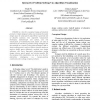Free Online Productivity Tools
i2Speak
i2Symbol
i2OCR
iTex2Img
iWeb2Print
iWeb2Shot
i2Type
iPdf2Split
iPdf2Merge
i2Bopomofo
i2Arabic
i2Style
i2Image
i2PDF
iLatex2Rtf
Sci2ools
INFOVIS
2000
IEEE
2000
IEEE
Interactive Problem Solving via Algorithm Visualization
COMIND is a tool for conceptual design of industrial products. It helps designers define and evaluate the initial design space by using search algorithms to generate sets of feasible solutions. Two algorithm visualization techniques, Kaleidoscope and Lattice, and one visualization of n-dimensional data, MAP, are used to externalize the machine’s problem solving strategies and the tradeoffs as a result of using these strategies. After a short training period, users are able to discover tactics to explore design space effectively, evaluate new design solutions, and learn important relationships among design criteria, search speed, and solution quality. We thus propose that visualization can serve as a tool for interactive intelligence, i.e., human-machine collaboration for solving complex problems.
Algorithm Visualization Techniques | Design Space | INFOVIS 2000 | Initial Design Space | Visualization |
| Added | 31 Jul 2010 |
| Updated | 31 Jul 2010 |
| Type | Conference |
| Year | 2000 |
| Where | INFOVIS |
| Authors | Pearl Pu, Denis Lalanne |
Comments (0)

